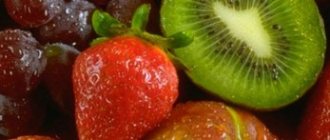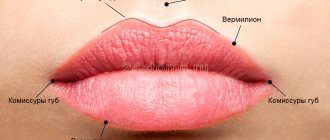Dangerous like cigarettes: what is the harm of sausage
No matter how convincingly they talk about the dangers of sausage, the demand for sausage products is only growing.
People are in no hurry to give up their favorite sandwiches with doctor’s sausage, sliced salami, and sausages with pasta. Together with bakery and dairy products, sausage takes an honorable third place in our grocery baskets. In the morning, sausage is an ideal breakfast and there is less hassle with dinner. So why are nutritionists and doctors so up in arms against her? Let's look at the reasons why the harm from sausage is equated to the harm from smoking.
What harm do processed meat products cause to the human body?
Processed meat products include a variety of products: any types of sausages, ham, bacon, sausages, dried, smoked, dry meat, canned meat, dumplings, cutlets, ham. In such products, the meat has been processed, stored in vacuum packaging, frozen, smoked or as sausages and sausages.
One way or another, we always knew about the dangers of sausage. Excessive consumption increases the risk of obesity and gastrointestinal diseases. However, over the past decades, the technology for making sausages has changed greatly. And excess weight has ceased to be the biggest problem for those who like to shop in sausage stores.
What is sausage made from?
The older generation still praises Soviet sausage. According to Soviet GOST, doctor's sausages had the following composition: 70% pork, 25% beef, 3% eggs, 2% milk.
What we have today:
The raw materials for the meat are animals that are fed corn and protein supplements (bones of other animals). They move little, so their meat is fatty and has a loose consistency.
Skin, bones and other by-products are also processed.
To make processed meat pink or red (and not a shapeless mass), sodium nitrite is added to it. This additive improves taste and kills bacteria, which is why it is added to all processed meat products. Unfortunately, there sodium nitrite is converted into nitrosamines, which provoke cancer.
Smoked meat products contain PAHs - polycyclic aromatic hydrocarbons. This additive is carcinogenic, that is, one that can cause malignant processes.
Heterocyclic amines and advanced glycation end products are other carcinogens found in all types of sausages, as they form when exposed to very high temperatures.
Soy protein, which is more abundant in sausage than meat.
Sugars, easily digestible carbohydrates, flavor enhancers. Sausages contain a lot of hidden sugar and carbohydrates, which leads to a high calorie content of the product. A flavor enhancer is considered a safe additive, but such products do not provide a feeling of fullness. You want to eat them and eat them.
They contain huge doses of salt and trans fats .
So, modern sausages and processed meat products have a complex chemical composition. Whereas a harmless sausage should contain nothing but meat and spices.
In 2020, the World Health Organization officially designated processed meat as a carcinogenic product that causes cancer.
Sausages, sausage, bacon, and ham are on a par with such dangerous substances for human health as tobacco and asbestos (arsenic sulfide).
The WHO's conclusion is based on 800 scientific studies from ten countries.
What diseases are caused by sausages?
Heart disease and hypertension (high blood pressure).
Chronic obstructive pulmonary disease (COPD).
Overweight and obesity.
Oncological diseases (intestinal cancer and stomach cancer).
Harm of sausages and frankfurters for children
How convenient, you give the child a sausage, and he is full, and you don’t spend a lot of time cooking. And that’s where all the benefits of sausages and frankfurters ended. After all, even in kindergartens they are given. And how compassionate grandmothers love to feed sausages to them, well, since the child does not eat borscht, he must be fed at least something, such logic amazes and scares me.
Very often, the substances included in the composition cause an allergic reaction, the digestion process is disrupted, because the products are not completely digested and they do not have much nutritional value. But as soon as children try sausage or frankfurters a couple of times, they become addicted and begin to demand them constantly.
But frequent consumption of these “meat” products leads to chronic diseases. But we continue to give sausages to our babies almost from the beginning of complementary feeding, consoling ourselves with the fact that the child likes it.
If you are not able to completely deny your child these products, then at least minimize consumption and choose relatively safe ones. Avoid packing hot pink sausages. It is better to let their color be grayish-pink. These products contain fewer dyes and preservatives. And look for packaging with a special symbol that the product is recommended for baby food, although these symbols do not provide any guarantees of usefulness and safety.
Sausage and frankfurters should not be very salty - this may be a sign of nitrate content. It is better if the shell is natural. If this shell bursts during heating, then it is artificial. If it wrinkles or, on the contrary, swells, there is too much carrageenan in the product.
Harm from sausage - how do sausages and frankfurters harm human health?
Why did doctors officially recognize sausages and frankfurters as unhealthy products? What in their composition provokes the development of stomach cancer and other diseases?
How are sausages and sausages harmful to health?
The dangers of sausage are not just a myth propagated by vegetarians. For several years now, the World Health Organization has compared the health risks arising from regular consumption of processed meat (sausages, hot dogs and other processed foods) with the danger posed by smoking cigarettes and using asbestos (1).
Experts note that processed meats significantly increase the risk of intestinal cancer and strongly recommend limiting the consumption of such products to 50 g per day. But what is in the composition of sausages and sausages that provokes such negative processes, and how much does a sausage that is “safe” for health cost?
What exactly is harmful in sausage?
It is necessary to understand that modern sausages are a complex chemical product, only a small part consisting of what an ordinary person could call “meat”. None of the key ingredients in the sausage can be considered natural, since they all undergo multi-stage and very aggressive processing.
Separately, it is worth noting that sausages and sausages are strictly prohibited from frying, boiling, or subjecting them to other heat treatment - the components they contain can oxidize and change under the influence of high temperatures, becoming even more powerful carcinogens that provoke various types of cancer.
Sausage composition: meat quality
Typical raw materials for the production of even expensive sausages are the so-called “intensively fed animals” kept under conditions of limited movement. Since such pigs and cows practically do not move, their meat becomes extremely fatty, while having a light color and loose consistency.
If under normal conditions a cow eats fresh grass, then a cow from a meat processing plant lives on corn (naturally, the cheapest and most modified) and protein supplements, which are often the ground bones of her fellow cows. The result is a shift in the fat balance towards harmful omega-6 fats contained in corn (2).
Vegetable proteins and fats
It is important to note that meat processing plants process up to 98% of the carcass of a killed animal. The fat from the skin and bones is rendered and added to the minced meat to produce a more “juicy” sausage. Additionally, hydrogenated vegetable fats are introduced into the product - unfortunately, during aggressive processing they contain dangerous trans fats.
Among other things, in cheap sausages and frankfurters, part of the meat can be replaced with soy protein. However, the main problem with this protein is not the soy itself, but, again, aggressive chemical processes. To give soybeans the desired textural properties, they can be soaked in an alkaline solution, bleached, and so on.
The main element of the composition: stabilizers
The initially light and loose meat, minced into fine mince, after adding vegetable fats, becomes even more colorless and looks like a shapeless mass. To create an elastic structure and a red “meaty” color, dyes and stabilizers are added. Both chemicals and dried blood can be used as a dye.
Starch and gelatin (typical ingredients of homemade jellied meat) were traditionally used as stabilizers and thickeners in the production of sausage, but now they have been replaced by hydrocolloids, which bind water and minced meat ten times better. To imagine their effect, think of wallpaper glue diluted in water.
Why can chicken breast, the most popular low-calorie fitness dish, be harmful to the health of athletes?
Sodium nitrite: a dangerous preservative
Sodium nitrite is added to sausage meat for two key reasons. Firstly, it is what gives the colorless mixture of animal and vegetable fats the familiar reddish-pink “sausage” color. Secondly, it is a powerful preservative that interferes with the development of cadaveric bacteria (without which, whatever one may say, the meat of a slaughtered animal is impossible).
Meat ingredients
Tails, intestines, skins, ligaments, cartilage, ground and boiled to a light gray pulp, are called emulsions, and sausages are prepared from this mass. Plus phosphates, starch, flavoring ingredients, dyes, soy, which is soaked in an alkaline solution and bleached to give the desired texture.
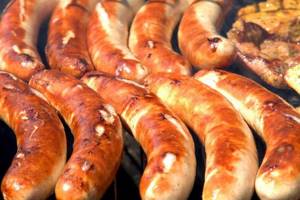
- Hydrocolloids are hydrophilic polymers, used as thickeners and stabilizers, dissolve and swell in water.
- Monosodium glutamate, a flavor enhancer, is not dangerous unless crushed under ultra-high pressure with carbon dioxide.
- Sodium nitrite is a preservative that gives color and prevents the development of bacteria. When processed, it turns into compounds that cause cancer.
- Excessive amounts of salt, sugar, carbohydrates.
- Trans fats are artificial types of fat found in palm oil.
- Carrot fiber, a dietary fiber produced abroad, absorbs water well when added to minced sausage.
When smoked and at high temperatures, carcinogens are formed: polycyclic aromatic hydrocarbons, heterocyclic amines.
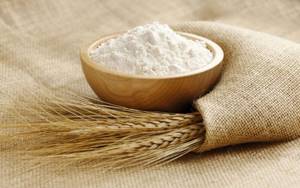
The flour and starch in the composition do not meet technical standards. 20% of products are produced according to GOST, 80% according to specifications (technical conditions), which are independently determined by each meat processing plant. Believe it or not, vacuum-packed slices are usually past their expiration date.
Liverwurst
To prepare this type of sausage, take liver (liver, heart, stomach, lungs, kidneys, ears, skins, udder) and add cereals and starch. Its calorie content is 326 kcal per 100 g. The presence of vitamins, minerals, and amino acids indicates its beneficial properties. But it is not often possible to buy high-quality products; except for liver, they also contain chemical additives, dyes, and starch. Excessive consumption aggravates existing diseases.
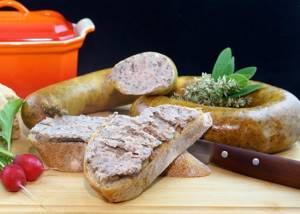
Liver sausage causes harm to the body: it increases cholesterol levels and contributes to water-salt imbalance. In addition, it is a perishable product. Nutritionists do not recommend using it for pregnant women, lactating women, pancreatitis, gastritis, or diabetes.
The benefits and harms of liver sausage are individual for everyone and depend on the quality of sausage you buy. When choosing, you should take into account that the product has four grades: highest, first, second, third. The liver is present in the first three, in the last it is replaced by the lung. It is advisable to buy a product with 30% liver content, color without dyes - gray, on the packaging the inscription “Made according to GOST”.
Blood sausage
It is prepared from animal blood, mixed with minced meat, offal and spices. Natural intestines are used as a casing and cereals are added. Some people make it at home, using their own recipes. Blood sausage brings both benefits and harm: it increases hemoglobin, contains a lot of protein and microelements, but is contraindicated for people with obesity, liver disease, gastrointestinal tract, and is difficult to digest and digest by the body.
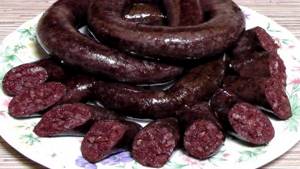
Blood sausage is a perishable product that can cause serious harm to health and cause poisoning. Calorie content – 379 kcal per 100 g.
Horse sausage
Horse sausage is a dish of the tribal peoples of Central Asia; they prepare it by hand, gathering the whole family. Horse meat contains the following useful substances: proteins, fats, carbohydrates, amino acids, vitamins, minerals. Horse meat is well digestible, lowers cholesterol, is hypoallergenic, and is considered dietary.
The harm of modern sausage
The harm of modern sausage
Alas, we have to admit the disappointing fact that the modern, so dearly beloved sausage is carrying more and more harm to our health. We sometimes wonder where some of our ailments come from, where very young children have acetone in their blood, and at the same time we don’t think at all that one of our enemies is very close. We ourselves raised him, nurtured him and put him on a pedestal...
Here it is, meet us - such a delicious, so beautiful, so dear to our hearts... sausage. Her Majesty Sausage! Yes, yes, she is the one!
What makes such a familiar product one of the most harmful to human health, and is this really so? Let's try to figure out what modern sausages are made of.
There are special GOSTs that clearly regulate the composition of a particular type of sausage, and in particular the amount of meat in it. However, many meat processing plants either do not adhere to the standards or even replace them with specifications (technical conditions), which they themselves develop. Therefore, you can find anything in sausage: various preservatives, emulsifiers, thickeners, flavor enhancers and even special additives that imitate the taste of meat.
Manufacturers keep their recipes for making cheap boiled sausage a big secret. Of course, it's their intellectual property!
But everything secret sooner or later becomes clear, and here is one of these recipes:
• soy protein – 25%;
• food additives - 2%.
As you can see, the total amount of meat is as much as 40%, but don’t flatter yourself about this! Not all meat that smells like meat... Read on to find out why.
The low purchasing power of the population forces manufacturers to produce cheap sausages. Think about it, but can a meat product cost much less than the meat itself? But the meat still needs to be processed, packaged, delivered to stores in the form of a finished product - sausage... So, are producers working at a loss? Of course not! And the low price of sausage can be explained very simply: it contains almost no meat, the most expensive ingredient.
You've probably noticed more than once that cats refuse to eat cheap sausage - you can't fool an animal!
When buying expensive sausage, we, alas, are also not immune from counterfeits. This is how it is in our country: expensive goods are not always of high quality.
Once, a familiar salesman in the sausage department advised me to buy not the smoked sausage that had just been brought to the store, but the one that had already been in the refrigerated display case for a couple of weeks. Why, I was surprised, is fresh sausage supposed to be better and tastier?
Everything is very simple! It turns out that according to technology, smoked sausage must hang for at least 15 days before going on sale, so that excess moisture evaporates from it and it reaches its condition.
What's really going on? Of course, manufacturers do not meet these deadlines. The sausage is piping hot, immediately after production it goes on the shelves, and you and I pay for the excess water, thereby increasing the manufacturer’s already high profits!
Even if the sausage does contain meat, it is usually frozen briquettes of pork or beef of dubious quality, which came to us from some distant Brazil. In addition, manufacturers replace pork or beef with a special chicken stuffing of Chinese origin, which, although there is no meat, has a taste, color, and smell “identical to natural”, and it costs much less than the meat itself!
And of course, all meat production waste is used - from ground intestines, tails, skin and other inedible parts of the animal, right down to finely ground bones. This is evidenced by the greenish tint of the sausage.
In order to somehow bind excess moisture and, accordingly, make the product even tastier and cheaper, phosphates are added to the sausage, which are very harmful to our health. They upset the balance between calcium and phosphorus in the human body, calcium is less absorbed, and, as a result, a disease such as osteoporosis may occur.
And in order to achieve a beautiful pink color and thus make the sausage more attractive to the buyer, nitrites are added, which lead to cancer.
When choosing sausage, remember that the brighter the color of the sausage, the higher the concentration of nitrates in it.
In the European Union, it has long been prohibited to add gelatin to sausage, as it can lead to a disease such as spongiform encephalopathy. And here, please, gelatin is a welcome guest in almost every type of sausage!
In addition, in sausages you can often find genetically modified soybeans, which are also used as a substitute for meat, and 9 out of 10 sausages contain starch.
More than half of the sausages are produced not in meat processing plants, but in underground workshops, in completely unsanitary conditions, and getting serious food poisoning from tasting such a sausage is a piece of cake!
One of my acquaintances, who works in a similar “leftist” workshop, told me that if people saw the whole process of preparing their favorite sausage, they would refuse to eat such a “delicacy” for the rest of their lives.
Carcinogens in meat products: what risks does frequent consumption of sausage pose to you?
What threatens us from frequent consumption of meat in general and sausages in particular? Is it possible to avoid the health risks associated with a meat diet? And why is red meat more harmful than white meat, any sausage is more harmful than even red meat, and fried sausage is much more dangerous than non-fried sausage?
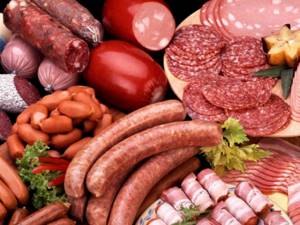
Proven carcinogenic effect of meat products
Frequent consumption of processed red meat, that is, foods such as:
- sausages
- ham and meat gastronomic products
- smoked meats
- cutlets, steaks, entrecotes, shish kebab and other natural and minced meat products
- shawarma, hamburgers and other fast food
- and so on.
is directly associated with an increased risk of cancer. According to research, such foods may primarily cause colon cancer.
At the same time, the carcinogenic effect of processed meat products can be considered fully proven - they are included in the 1st group of carcinogenic factors according to the IARC classification, which means: “ proven carcinogenic effect for humans .”
But red meat itself (that is, beef and pork) is also included in this list of carcinogenic factors, but in group 2a - factors “ probably carcinogenic to humans .
The warmer it is, the more harmful it is
When cooking food, including natural meat, various Maillard reaction products are formed in it - substances that appear when proteins are heated along with glucose, fats and aldehydes.
It is thanks to the substances formed during this reaction that our food receives the taste and aroma that are specific to each dish. However, among these substances there are also carcinogenic ones. And the higher the heating temperature, the more such substances are formed.
For example, when meat is heated with the participation of the creatine contained therein, various carcinogenic compounds from the group of heterocyclic amines are formed.
It is traditionally believed that red meat is more dangerous in this regard than poultry or fish. That is why red meat itself is also listed as a carcinogen. And, of course, the method of preparation is very important. From the point of view of healthy eating, boiling, stewing and baking meat is more preferable.
Roasting is the most dangerous and unhealthy way to cook meat.
When frying, the most harmful products of the Maillard reaction are formed, as well as various products of fat peroxidation (fatty acid epoperoxides), aldehydes and other substances.
Why is sausage harmful a priori?
Any sausage product necessarily contains nitrites, since without them the production of sausage is impossible in principle. Sausages made without the use of nitrites will be dangerous due to the possibility of the development of the causative agent of botulism in it.
Once in the human digestive tract, nitrites can turn into carcinogenic nitrosamines!
Of all types of sausages, the most dangerous are smoked, semi-smoked, boiled-smoked sausages and meat deli products, since, in addition to nitrites, they also contain carcinogenic compounds from the group of polycyclic aromatic hydrocarbons (PAHs), which are formed during thermal decomposition (pyrolysis) of the wood used when smoking. The best known compound from this group is benzo(a)pyrene.
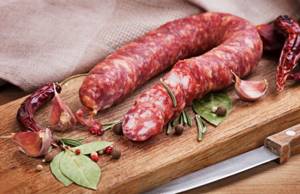
The opinion of the authors of the Community may not coincide with the official position of the Roskontrol organization. Do you want to add or object? You can do this in the comments or write your own material.
Every week we talk about new comparative tests of food and household appliances. Short and to the point.
In my opinion, the article is not intended to turn everyone into vegans. The only fact that is stated is that smoked and fried meat products, while their benefits tend to zero, have a scientifically proven negative effect on the body. Meat that is not subjected to chemical treatment (which accelerates the “ripening” of the product) or rough heat treatment does not have the negative properties that are characteristic of such semi-finished products. It is not the meat itself that is evil, but the method of “industrial” preparation that turns it into a carcinogen. Specific thesis: when consuming 50 g of smoked semi-finished meat products, the likelihood of developing colorectal cancer increases by 18%.
As for IARC, it is an authoritative international organization (International Agency for Research on Oncology) with its head office in Lyon (France), which in 1994 elevated Helicobacter pylori infection to the rank of a top-class carcinogen, which is the cause of 97% of cases of stomach cancer. Australian scientists received the Nobel Prize in 2005 for the discovery of this infection. I have been working in this field for 10 years and I have no reason not to trust their conclusions.
It’s better to take this information as a given and draw the appropriate conclusions than to then whistle like a rubber hedgehog with a hole (in this case) in the left side, called a colostomy.
Why are sausages and sausages harmful?
To date, a huge amount of scientific research has been carried out, which has proven that industrially processed meat consumed daily increases the risk of developing diseases such as:
- arterial hypertension
- heart and vascular diseases
- chronic obstructive pulmonary disease
- oncological diseases of the gastrointestinal tract
They also contribute to excess weight gain and obesity.
What components of sausages and ready-made cutlets lead to such devastating health consequences? Obviously, this is not meat, fat or spices. What then?
Sodium nitrite
Sodium nitrite is always used to produce meat products. The reason for the popularity of this chemical in the food industry is that sodium nitrite has several properties that are remarkable for this industry. He:
- improves the color of sausages, making them pink instead of gray
- prevents products from burning due to fat oxidation
- helps fight the proliferation of pathogenic bacteria.
There is nothing wrong with sodium nitrite in itself. However, in industrially processed meat, sodium nitrite often turns into various N-nitroso compounds, such as nitrosamines, which are known to cause cancer.
Polycyclic aromatic hydrocarbons (PAHs)
Polycyclic aromatic hydrocarbons are formed when organic compounds burn. In relation to the production of meat products, this means that most of them are in those delicacies that were produced by smoking. All of these products carry traces of smoke, which contains quite a lot of PAHs.
The main harm of polycyclic aromatic hydrocarbons lies in their carcinogenic properties.
Heterocyclic amines
Another class of carcinogenic compounds that are also present in many prepared meat products. However, you can get such a delight as heterocyclic amines at home, if the meat is exposed to very high temperatures for a very long time, for example, by frying.
But if meat is cooked, especially steamed, or stewed at a not very high temperature, heterocyclic amines are not formed.
In industry, extremely high temperatures are used to prepare stew, sausages or hamburgers, and therefore heterocyclic amines are usually present in these food products.
Glycation end products
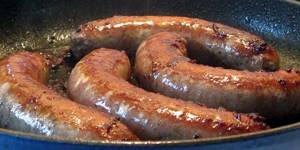
Like heterocyclic amines, these molecules are also formed when meat is cooked at very high temperatures.
Once in the body, advanced glycation end products cause oxidative stress and inflammation, which lead to the development of heart, vascular, and kidney diseases, diabetes and cancer.
Salt
We have already said that a salt-free diet can be deadly. Therefore, it may seem that there is nothing wrong with the fact that sausages, hams and carbonates carry salt. In principle, this is the case if you made the sausage yourself and salted it properly.
But industrially produced meat products usually contain not a lot, but a lot of salt.
When cooking at home, it is almost impossible to salt food so that salt consumption exceeds the permissible limits. But with regular heavy consumption of ready-made meat dishes, it is very easy to oversaturate your body with salt.
Excessive salt consumption not only increases the risk of developing hypertension and cardiovascular diseases, but can also provoke the occurrence of certain types of cancer, such as stomach cancer.
Flavor enhancers
These chemicals, the best known of which is monosodium glutamate, are closely linked to the problem of overeating and all the resulting consequences from obesity to diabetes and hypertension.
The point of using flavor enhancers by the food industry is to make people eat, and therefore buy, more and more. Food with flavor enhancers does not fill you up. It often has the opposite effect: the more you eat it, the more you want to chew further.
All industrially produced deli meats today contain flavor enhancers. And if monosodium glutamate is not indicated on the packaging, this only means that in this type of sausage it is replaced by some other compound with similar properties.
You can read more about the harmful effects of monosodium glutamate on the human body, and how natural beneficial glutamate differs from artificial glutamate in this material.
Sugars and carbohydrates
Strange as it may seem, industrial meat products, especially inexpensive sausages, sausages, and cutlets, contain sugar. Sometimes in quite a large volume. As well as other not very healthy carbohydrates, for example, semolina.
The presence of sugars and other carbohydrates again links industrial meat products with the problem of excess weight and its negative consequences.
Someone might argue that sausage is not candy, and there is not that much sugar in it. Certainly. But this is unaccounted for, so-called hidden sugar, sugar that a person may not even be aware of consuming.
And often it is the consumption of such hidden sugar and hidden easily digestible carbohydrates that nullifies all attempts of those losing weight to give up sweets or switch to a carbohydrate-free diet. People think they are following the rules - eating protein with healthy fat, but in reality they are eating carbohydrates again.
Soy protein
Soy products are now included in almost all meat products. Often there may be more soy in such “meat” than the meat itself.
The harm of soy is colossal and is associated with a whole bunch of health problems.
Trans fats and vegetable oils
In theory, sausages and hams should include healthy animal fats. But this is theoretical. In fact, they contain trans fats, which the modern food industry cannot do without. And if he does, he replaces them with those vegetable oils that are not much healthier than trans fats, for example, rapeseed, soybean, sunflower.
Here you can read more about why trans fats and vegetable fats are so bad for your health.
Of course, even with such a huge number of harmful ingredients, prepared meat products cannot be considered poison. But they are very harmful. It is a fact. Therefore, you can allow yourself to be “poisoned” by them only sometimes – on holidays. But under no circumstances should you eat every day or live “on sausages.”
At the same time, homemade sausage, ham or lard are healthy food products suitable for a healthy menu for every day.
The harm of sausages
It is precisely these same three percent of various additives that cause the greatest harm to our body. After all, this is not only ordinary table salt (although it is harmful) and spices beloved by many, but also flavors, dyes, thickeners, preservatives, etc. Let’s take a closer look at the chemical additives that cause harm.
Main chemical additives in sausages and sausages
Sodium nitrite
It has been used in sausage production for a long time. And all thanks to its remarkable properties - it improves the presentation (making sausages a beautiful pink color), prevents the development of pathogens and prevents fats from oxidizing. According to the norms, it is added at 7 grams. for every 100 kg of minced meat. There is nothing terrible in this substance itself, but its derivatives, for example, nitrosamines, can cause cancer.
Heterocyclic amines
Present in sausages, stews and other meat products, the production of which uses high temperatures. Carcinogens, which means they cause cancer.
Salt
There is nothing wrong with the fact that these products contain sodium chloride, but how much is there, do you know? But products produced on an industrial scale contain not just a lot of it, but a lot! Daily consumption can lead to oversalting of the body, which increases the risk of cardiovascular diseases and hypertension. And also provoke the development of cancer.
Monosodium glutamate
The most famous flavor enhancer that people love to add to chips. Its presence in itself does not harm the body, unless you eat it in tablespoons. In this case, you are guaranteed headaches and increased heartbeat, weakness and chest pain.
Scientists associate another problem with this substance – obesity. After all, the very meaning of its presence in products is to make a person eat more and more. Didn't find it included on the package? It has probably been replaced by another substance with a similar property.
Trans fats and vegetable oils
It would seem that sausages and frankfurters are meat products and should include only animal fats. But that's not true! Not a single food industry can do without palm oil as a cheap material. Everyone wants money. So either harmful trans fats or cheap vegetable oils are used - rapeseed, soybean, etc.
Phosphoric acid salts
Substances that help retain moisture in sausages and sausages. Most often found in the form of food additives E450 (pyrophosphates), E451 (triphosphates), E452 (polyphosphates). Frequent and excessive consumption leads to an imbalance of phosphorus and calcium in the body, which causes brittle bones (osteoporosis).

